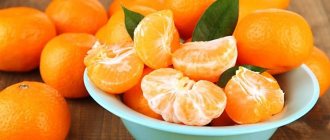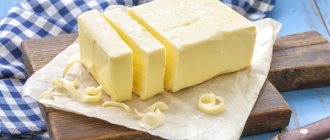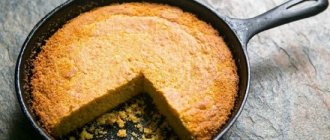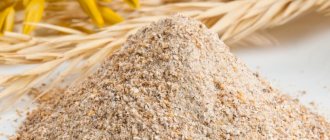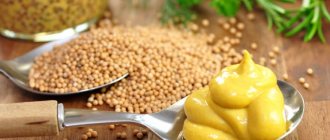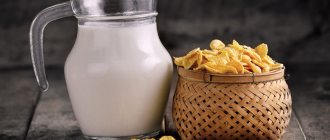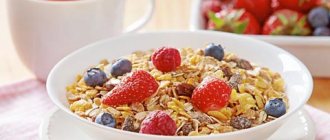Nutritional value and chemical composition of rye flatbread
The color of the rye grains, from which rye flour is obtained and flatbreads are baked, varies: gray-green, yellow and brown. Rye, and rye bread made from it, is in first place in consumption all over the world. Slavic peoples especially love rye bread and rye cakes, and for good reason: rye flour contains vitamins B1, B2, B5, B6, B9, E, A, H, PP and beta-carotene. The chemical composition is unique and balanced and includes:
- calcium, potassium, magnesium, zinc, selenium, copper;
- manganese, iron, chlorine;
- sulfur, chromium, iodine, fluorine, molybdenum, boron, vanadium, silicon, cobalt;
- tin, titanium, nickel, aluminum, sodium, phosphorus.
100g of rye flatbread contains:
- Proteins – 8.
- Fats – 18.3.
- Carbohydrates – 44.2.
- Kcal – 376.
Rye flatbreads are full of variety. Manufacturers bake them by adding all sorts of ingredients: seasonings, cracklings, spices, cheese, fruits and berries.
Caution for use. Please note that bread made with rye flour is not advisable for people suffering from gastrointestinal diseases. It increases the acidity of gastric juice, so heartburn and undesirable consequences may occur with constant consumption of all types of rye baked goods.
Making classic rye flatbread at home
Rye flatbread can be prepared very simply at home.
Ingredients:
- 150g rye flour;
- 100g wheat flour;
- 10g dry yeast;
- 200ml water;
- 20g butter margarine;
- 0.5 teaspoon salt;
- 2 teaspoons sugar.
Preparation:
- Dissolve the yeast in 100 ml of warm water, add sugar, cover the container with cling film and let the foam rise.
- Mix wheat flour with rye and salt.
- Pour the remaining water into the container with the yeast, add the flour and knead the dough, kneading thoroughly so that it is not clogged and elastic.
- Cover with film and leave to rise for 1.5 hours.
- Divide the finished dough into 4 parts, form into flat cakes and place on a greased baking sheet.
- After 30 minutes, bake in the oven at 200º C until done.
- Cover the finished bread with a towel and leave for an hour.
As you can see, preparing rye flatbreads is simple. At the same time, you will receive high-quality bread without all kinds of additives and dyes. Eating flatbreads made from rye flour perfectly strengthens the immune system and normalizes digestion, if there are no contraindications from a gastroenterologist.
Ingredients Rye flatbreads
Cooking method
Grind the softened (but not melted) margarine with a wooden spoon with a small amount of flour into which soda is mixed, beat in the egg, grind, add honey and grind again. Then add flour until the dough is thick enough to form into flatbreads. Roll the dough into a “sausage”, divide into equal pieces, make flat cakes from them and place on a baking sheet. Bake at t=180-200 degrees for about 20 minutes. Willingness to identify with a torch. Place the finished cakes in a dry enamel pan, cover and let them cool slightly. margarine 125 g. honey 2 tbsp. l. soda 1 tsp. rye flour 3-4 cups egg 1 pc.
You can create your own recipe taking into account the loss of vitamins and minerals using the recipe calculator in the application.
CHEMICAL COMPOSITION AND NUTRITIONAL ANALYSIS
Nutritional value and chemical composition of “Rye flatbreads”.
The table shows the nutritional content (calories, proteins, fats, carbohydrates, vitamins and minerals) per 100 grams of edible portion.
| Nutrient | Quantity | Norm** | % of the norm in 100 g | % of the norm in 100 kcal | 100% normal |
| Calorie content | 390 kcal | 1684 kcal | 23.2% | 5.9% | 432 g |
| Squirrels | 5.2 g | 76 g | 6.8% | 1.7% | 1462 g |
| Fats | 17.8 g | 56 g | 31.8% | 8.2% | 315 g |
| Carbohydrates | 55.8 g | 219 g | 25.5% | 6.5% | 392 g |
| Organic acids | 0.1 g | ~ | |||
| Alimentary fiber | 0.3 g | 20 g | 1.5% | 0.4% | 6667 g |
| Water | 18.4 g | 2273 g | 0.8% | 0.2% | 12353 g |
| Ash | 0.6 g | ~ | |||
| Vitamins | |||||
| Vitamin A, RE | 100 mcg | 900 mcg | 11.1% | 2.8% | 900 g |
| Retinol | 0.1 mg | ~ | |||
| Vitamin B1, thiamine | 0.1 mg | 1.5 mg | 6.7% | 1.7% | 1500 g |
| Vitamin B2, riboflavin | 0.09 mg | 1.8 mg | 5% | 1.3% | 2000 g |
| Vitamin B4, choline | 17 mg | 500 mg | 3.4% | 0.9% | 2941 g |
| Vitamin B5, pantothenic | 0.1 mg | 5 mg | 2% | 0.5% | 5000 g |
| Vitamin B6, pyridoxine | 0.09 mg | 2 mg | 4.5% | 1.2% | 2222 g |
| Vitamin B9, folates | 23.6 mcg | 400 mcg | 5.9% | 1.5% | 1695 g |
| Vitamin B12, cobalamin | 0.03 mcg | 3 mcg | 1% | 0.3% | 10000 g |
| Vitamin C, ascorbic acid | 0.2 mg | 90 mg | 0.2% | 0.1% | 45000 g |
| Vitamin D, calciferol | 0.1 mcg | 10 mcg | 1% | 0.3% | 10000 g |
| Vitamin E, alpha tocopherol, TE | 6.4 mg | 15 mg | 42.7% | 10.9% | 234 g |
| Vitamin H, biotin | 2.6 mcg | 50 mcg | 5.2% | 1.3% | 1923 |
| Vitamin RR, NE | 1.5632 mg | 20 mg | 7.8% | 2% | 1279 g |
| Niacin | 0.7 mg | ~ | |||
| Macronutrients | |||||
| Potassium, K | 75.6 mg | 2500 mg | 3% | 0.8% | 3307 g |
| Calcium, Ca | 18.9 mg | 1000 mg | 1.9% | 0.5% | 5291 g |
| Magnesium, Mg | 16.8 mg | 400 mg | 4.2% | 1.1% | 2381 g |
| Sodium, Na | 52.6 mg | 1300 mg | 4% | 1% | 2471 g |
| Sera, S | 43.9 mg | 1000 mg | 4.4% | 1.1% | 2278 g |
| Phosphorus, Ph | 95.7 mg | 800 mg | 12% | 3.1% | 836 g |
| Chlorine, Cl | 12 mg | 2300 mg | 0.5% | 0.1% | 19167 |
| Microelements | |||||
| Iron, Fe | 2 mg | 18 mg | 11.1% | 2.8% | 900 g |
| Yod, I | 1.5 mcg | 150 mcg | 1% | 0.3% | 10000 g |
| Cobalt, Co | 0.7 mcg | 10 mcg | 7% | 1.8% | 1429 g |
| Manganese, Mn | 0.0051 mg | 2 mg | 0.3% | 0.1% | 39216 g |
| Copper, Cu | 11 mcg | 1000 mcg | 1.1% | 0.3% | 9091 g |
| Molybdenum, Mo | 0.4 mcg | 70 mcg | 0.6% | 0.2% | 17500 g |
| Fluorine, F | 13.1 mcg | 4000 mcg | 0.3% | 0.1% | 30534 g |
| Chromium, Cr | 0.3 mcg | 50 mcg | 0.6% | 0.2% | 16667 g |
| Zinc, Zn | 0.0813 mg | 12 mg | 0.7% | 0.2% | 14760 g |
| Digestible carbohydrates | |||||
| Starch and dextrins | 40 g | ~ | |||
| Mono- and disaccharides (sugars) | 9.6 g | max 100 g | |||
| Sterols (sterols) | |||||
| Cholesterol | 37.1 mg | max 300 mg |
The energy value of rye flatbread is 390 kcal.
Main source: Internet. .
** This table shows the average levels of vitamins and minerals for an adult. If you want to know the norms taking into account your gender, age and other factors, then use the My Healthy Diet app.
Calorie content of flatbreads 262.5 kcal
Energy value of flatbreads (ratio of proteins, fats, carbohydrates - bju):
: 8.8 g (~35 kcal) : 2.2 g (~20 kcal) : 51.9 g (~208 kcal)
Energy ratio (b|w|y): 13%|8%|79%
rye flatbread
rich in vitamins and minerals such as: vitamin B1 - 15.1%, vitamin E - 22.7%, vitamin PP - 14.1%, potassium - 14.2%, magnesium - 19.8%, phosphorus - 28, 1%, chlorine - 27.8%, iron - 18.2%, manganese - 34.5%, copper - 12.4%, molybdenum - 13.3%
- Vitamin B1
is part of the most important enzymes of carbohydrate and energy metabolism, providing the body with energy and plastic substances, as well as the metabolism of branched amino acids. A lack of this vitamin leads to serious disorders of the nervous, digestive and cardiovascular systems. - Vitamin E
has antioxidant properties, is necessary for the functioning of the gonads and heart muscle, and is a universal stabilizer of cell membranes. With vitamin E deficiency, hemolysis of erythrocytes and neurological disorders are observed. - Vitamin PP
is involved in redox reactions of energy metabolism. Insufficient vitamin intake is accompanied by disruption of the normal condition of the skin, gastrointestinal tract and nervous system. - Potassium
is the main intracellular ion that takes part in the regulation of water, acid and electrolyte balance, and is involved in the processes of conducting nerve impulses and regulating blood pressure. - Magnesium
is involved in energy metabolism, the synthesis of proteins, nucleic acids, has a stabilizing effect on membranes, and is necessary to maintain the homeostasis of calcium, potassium and sodium. A lack of magnesium leads to hypomagnesemia, an increased risk of developing hypertension and heart disease. - Phosphorus
takes part in many physiological processes, including energy metabolism, regulates acid-base balance, is part of phospholipids, nucleotides and nucleic acids, and is necessary for the mineralization of bones and teeth. Deficiency leads to anorexia, anemia, and rickets. - Chlorine
is necessary for the formation and secretion of hydrochloric acid in the body. - Iron
is part of proteins with various functions, including enzymes. Participates in the transport of electrons and oxygen, ensures the occurrence of redox reactions and activation of peroxidation. Insufficient consumption leads to hypochromic anemia, myoglobin deficiency atony of skeletal muscles, increased fatigue, myocardiopathy, and atrophic gastritis. - Manganese
is involved in the formation of bone and connective tissue, and is part of enzymes involved in the metabolism of amino acids, carbohydrates, and catecholamines; necessary for the synthesis of cholesterol and nucleotides. Insufficient consumption is accompanied by slower growth, disturbances in the reproductive system, increased fragility of bone tissue, and disturbances in carbohydrate and lipid metabolism. - Copper
is part of enzymes that have redox activity and are involved in the metabolism of iron, stimulates the absorption of proteins and carbohydrates. Participates in the processes of providing oxygen to the tissues of the human body. Deficiency is manifested by disturbances in the formation of the cardiovascular system and skeleton, and the development of connective tissue dysplasia. - Molybdenum
is a cofactor for many enzymes that ensure the metabolism of sulfur-containing amino acids, purines and pyrimidines.
more hide
You can see the complete directory of the most useful products in the application
Product calorie analysis
SHARE OF BZHU IN CALORIES
Ratio of proteins, fats and carbohydrates:
How much do tortillas cost (average price for 1 piece)?
Moscow and Moscow region.
It is no secret that almost every people living on planet Earth has its own original recipe for bread, which people have been eating for centuries. Flatbreads are called “Central Asian bread”. It is no coincidence that this name was given to flatbreads in the global culinary tradition. It is believed that flatbreads belong to the traditional cuisine of countries located in the Central Asian region.
Researchers believe that flatbreads were the ancestors of other types of bread, as well as baked goods. As it turned out, people became acquainted with bread by chance, when a paste of cereals and water fell on an open fire and baked. This is how people made the first bread or cereal cake. It is worth noting that the flatbread differs from other types of bread in its original appearance.
Composition of flatbreads
This is also not at all accidental. In ancient times, people worshiped many natural phenomena that they could not explain and revered the sun. The flatbreads were made in the shape of a heavenly body and used as ritual food. It's not just the appearance that's different. But also the composition of the flatbread. Although the basis of the composition of flatbreads is formed by dough from various types of flour and their mixtures, usually spices and herbs, as well as various fillings, are added to the baked product.
The calorie content of flatbreads depends on the composition of the ingredients and, above all, on the nutritional value of the filling, which is used in the process of making the baked goods. According to average data, the calorie content of the flatbreads is 262.5 Kcal. There are several main types of flatbreads, which differ both in the type of dough and nationality. There are flatbreads made from rye flour, as well as from unleavened or rich dough. In addition, flatbreads may differ in the way they are prepared.
For example, the flatbread tadir-nan is baked in a special traditional Asian tandoor oven. Among the most popular types of traditional national flatbreads of different nations are the following:
- lavash or thin wheat flatbread, characteristic of the peoples of the Caucasus, as well as the Middle East;
- pita or Mediterranean flatbread;
- matzo, unleavened flatbread;
- traditional Indian flatbreads chapati, roti and naan;
- Italian type of focaccia flatbread, as well as traditional pizza;
- Latin American corn tortilla.
Main conclusions
Diet flatbreads are simple to prepare, have a wonderful taste and moderate calorie content.
The main ingredients for their preparation are flour, cottage cheese, eggs and additional additives that regulate the taste of flour products. Now about each of the components in order.
Cottage cheese is one of the most commonly used ingredients when baking dietary flatbreads. It has a unique composition and effect on the human body.
Its advantages include:
- rich in essential amino acids;
- slow rate of digestion, due to which the feeling of fullness is extended for up to several hours;
- easily digestible natural milk fat;
- a large amount of calcium in its composition.
Cottage cheese can normalize the functioning of the gastrointestinal tract, improve the condition of intestinal microflora, and lower cholesterol levels.
In dietary baking, cottage cheese is used to increase the volume of the dough, and also as a low-calorie alternative to butter or margarine to give the dough elasticity and softness. Baked goods made from curd dough remain airy longer and become stale slower. For dietary flatbreads, low-fat cottage cheese with the lowest calorie content is used.
The second ingredient is flour. Of course, we are not talking about gluten-rich wheat, but about healthier types: oatmeal, buckwheat, corn, rye and chaff. If we are talking about dessert varieties of flatbreads, then it is quite possible to use mixed options from coconut and oat flour or from flaxseed and nut.
In addition to flour, it is allowed to use oat and corn bran, which do not contain fast carbohydrates and at the same time have a beneficial effect on digestion processes. To improve the taste of flatbreads, bran is used not in its pure form, but in a mixture with some useful type of vegetable flour.
Oat bran is one of the main recommendations of Pierre Dukan, since, in his opinion, this product significantly speeds up metabolism.
Eggs increase the elasticity of the dough, “glue” all its components, create porosity, and improve taste. In dietary recipes, it is permissible to use only proteins, since they give the structure of baked goods the necessary softness. But yolks, on the contrary, are a source of animal cholesterol, which does not fit well into any diet. Quail eggs contain less cholesterol, so during the period of weight correction they can easily replace their chicken counterparts.
The most common additional additives are:
- flax seeds, chia, sesame;
- fresh greens and dry herbs;
- spices and sea salt;
- low-calorie cheese;
- vegetables (carrots, pumpkin, zucchini).
If you add filling to the flatbread, it can become a complete snack and help keep you feeling full for a long time.
Be sure to check out:
Diet flatbreads are easy to prepare and very variable. This is the most convenient low-calorie snack option that you can quickly make at home or take with you on the road:
- The recipe for diet flatbreads does not use wheat flour. It is replaced with more useful varieties or bran.
- Cottage cheese in the recipe is an alternative to butter.
- To make the cakes more fluffy, you need to add kefir and soda to the dough.
- The filling can be based on soft cottage cheese, low-fat cheese, herbs, vegetables and fish.
- Flax seeds or sesame are often used as additional ingredients.
- Diet flatbreads are a complete meal (breakfast, snack).
- You can replace the flatbreads with diet pies or baked pancakes.
We invite you to familiarize yourself with Scandinavian-style houses: 48 photos of interior design
Flatbread is a versatile option that can be prepared for work, school, or taken with you on a trip. The variety of fillings will allow you to create a dish that suits any taste.


